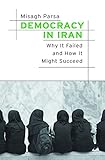Democracy in Iran : Why It Failed and How It Might Succeed / Misagh Parsa.
Material type: TextPublisher: Cambridge, MA : Harvard University Press, [2017]Copyright date: ©2016Description: 1 online resource (376 p.)Content type:
TextPublisher: Cambridge, MA : Harvard University Press, [2017]Copyright date: ©2016Description: 1 online resource (376 p.)Content type: - 9780674970434
- 320.955 23
- DS318.825 P38 2016eb
- online - DeGruyter
| Item type | Current library | Call number | URL | Status | Notes | Barcode | |
|---|---|---|---|---|---|---|---|
 eBook
eBook
|
Biblioteca "Angelicum" Pont. Univ. S.Tommaso d'Aquino Nuvola online | online - DeGruyter (Browse shelf(Opens below)) | Online access | Not for loan (Accesso limitato) | Accesso per gli utenti autorizzati / Access for authorized users | (dgr)9780674970434 |
Frontmatter -- Contents -- Preface -- Part I. Introduction and Theory -- 1. Iran’s Dilemma -- 2. Alternative Routes to Democracy: Synthesizing Structures and Processes -- Part II. Revolution and The Political Economy of Theocracy -- 3. Ideologies, Revolution, and the Formation of a Theocracy -- 4. Politicization of the Economy and Declining Performance -- 5. Failure to Reform and a Return to Repression -- Part III. Challenges Against The Islamic Regime -- 6. Students: Vanguard of Struggles for Democracy -- 7. The Rise and Demise of the Green Movement -- Part IV. Irreconcilable Conflicts -- 8. Why the Movement Failed -- 9. Irreconcilable Conflicts and Endless Repression -- 10. The Path Forward -- Notes -- Index
restricted access online access with authorization star
http://purl.org/coar/access_right/c_16ec
The Green Movement protests that erupted in Iran in 2009 amid allegations of election fraud shook the Islamic Republic to its core. For the first time in decades, the adoption of serious liberal reforms seemed possible. But the opportunity proved short-lived, leaving Iranian activists and intellectuals to debate whether any path to democracy remained open. Offering a new framework for understanding democratization in developing countries governed by authoritarian regimes, Democracy in Iran is a penetrating, historically informed analysis of Iran’s current and future prospects for reform. Beginning with the Iranian Revolution of 1979, Misagh Parsa traces the evolution of Iran’s theocratic regime, examining the challenges the Islamic Republic has overcome as well as those that remain: inequalities in wealth and income, corruption and cronyism, and a “brain drain” of highly educated professionals eager to escape Iran’s repressive confines. The political fortunes of Iranian reformers seeking to address these problems have been uneven over a period that has seen hopes raised during a reformist administration, setbacks under Ahmadinejad, and the birth of the Green Movement. Although pro-democracy activists have made progress by fits and starts, they have few tangible reforms to show for their efforts. In Parsa’s view, the outlook for Iranian democracy is stark. Gradual institutional reforms will not be sufficient for real change, nor can the government be reformed without fundamentally rethinking its commitment to the role of religion in politics and civic life. For Iran to democratize, the options are narrowing to a single path: another revolution.
Mode of access: Internet via World Wide Web.
In English.
Description based on online resource; title from PDF title page (publisher's Web site, viewed 24. Aug 2021)


